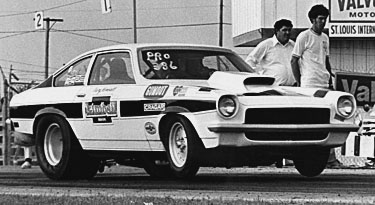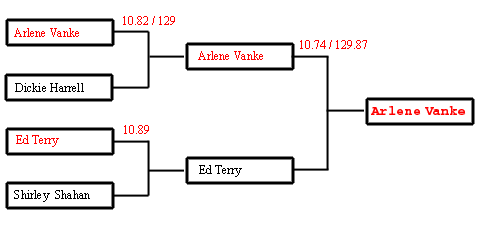|
Not only did the number of races increase, but so did the classes. At
the 1968 AHRA Winternationals at Beeline, a heads-up Super Stock Eliminator
class was introduced where model year (or close to it) cars such as
427-cid Mustangs and Camaros and 426 Dodges ran heads-up in a classification
which would lead to the formation of Pro Stock. These high 10-second,
128-130-mph cars proved to be a big hit with the fans.
Jim Tice, Jr., son of the late AHRA president Jim Sr., recalled the
motivation for the class. “The sponsors were involved in the more
stock appearing cars at the time,” he said. “We realized that
they wanted real heads up competition to set performance standards and
to contest the other brands. So that was the idea behind what we referred
to as Heads Up Super Stock Eliminator.
 |
Gary Kimball, the first AHRA Heads Up Super
Stock points champ in 1969, seen here at St. Louis a few years later.
Photo by Doug Heuton |
“In 1969, we gave points to the class and produced our first World
Champion (Gary Kimball) and we went even further than that. We also
ran a GT-1 and GT-2 class which were also heads up and could be seen
as "junior Pro Stock" or junior Heads-Up Super Stock categories. There
wasn’t all that much difference between them. I remember that outside
of weight and some minor modifications the GT-1 cars ran a single four-barrel
and the GT-2 cars ran a single 2 barrel. Of course, the big Super Stocks
ran dual four-barrel carburetors.”
Although AHRA ran Heads Up Super Stock (eventual Pro Stock class) in
1968, there were no rules published in their 1968 rule book. If anything,
it was a showcase eliminator. In 1969, AHRA ran Super Stock as a full-on
eliminator with the first race taking place at their Winternationals
in Arizona. Below are the semi-finals and finals of this historic encounter.

The pro racers were not the only ones caught up in the swirl of activity
in AHRA. The organization's bursts of creativity showed at all levels
of competition.
As one example, there was a story at AHRA races about this time that
a particular entrant had some unusual off-beat brand of car and wanted
to compete at one of the national events. AHRA tech officials looked
askance at the car, believed to be an Isetta 300 (although not for sure)
and told the concerned competitor that if they didn't have a class for
him they would create one on the spot.
This probably is not a myth. According to a Sept. 1968 Super Stock
magazine, the AHRA Springnationals at Bristol, Tenn., had 413 (!) classes
and 15 eliminators decided on the weekend. If you recall, AHRA first
referred to themselves in their beginnings as “the only democratic
national hot rod association.” Those numbers show democracy bordering
on seeming anarchy.
 |
page 5 of 6 |
 |
|